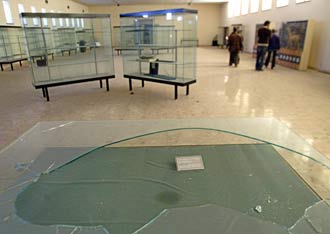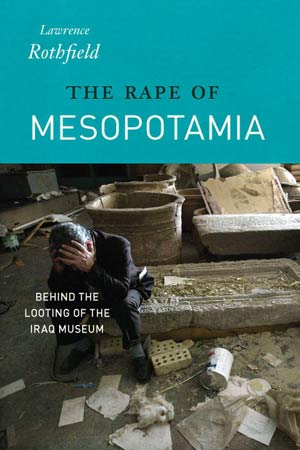
The Rape of Mesopotamia is about the series of missteps, missed opportunities, and miscommunications that led to the massive looting of Iraq’s cultural heritage after the U.S. invasion in 2003. Most people know about the looting of the Iraq Museum, but horrific as that was, the subsequent years-long pillaging of thousands of Mesopotamian archaeological sites under the nose of occupation authorities was even worse. Most people ask how such a thing could happen, as if that were merely a rhetorical question. After all, archaeologists say, we told the military looting would occur. That is true – in fact, the military, the Pentagon, and even the State Department’s point man Ryan Crocker were all told. None of them acted to prevent the disaster. Understanding why not is not a simple matter. I interviewed dozens of soldiers, bureaucrats, war planners, archaeologists, and collectors, ranging from the Pentagon official in charge of post-combat humanitarian assistance to the commander of the tank unit who was told to approach the museum to investigate reports of looting.
The story that emerged did include some incompetence and indifference. For the most part, however, those involved in the disaster were acting in good faith and with the best of motives. The looting of Iraq’s national museum and archaeological sites stemmed from deeper causes: the war fighting posture of the American military since World War II; the international framework of conventions for the protection of cultural property in times of armed conflict; the very American refusal to recognize culture as a sector like health, education, or energy, requiring the attention of policymakers; the focus of cultural heritage NGOs on conserving and developing sites rather than on securing them; and the absence of long-term relationships between archaeologists and the military that might have made it easier for advocates to put their case to those in a position to have done something.
I’d like readers to think of this book as something like Thomas Ricks’ Fiasco—but Fiasco for Cultural Heritage. It is contemporary history with a critical edge, or if you like, political journalism. As with Ricks’ book, I hope readers will come away from mine not just appalled but better informed about what needs to be done to make sure that this disaster is never repeated.
“I simply had failed to consider that policies, organizations, and leadership to protect cultural heritage might be so weak that the museum and sites could be left unsecured.”
It is a pretty twisted professional path that leads a cultural critic like me to become an expert on the history of the Army’s Civil Affairs division, fluent in the alphabet soup of military acronyms, and conversant in the legal niceties of the 1954 Hague Convention for the protection of Cultural Property in the Event of Armed Conflict. But one branch of cultural studies has always been interested in the ways in which culture is policed. Edward Said, my dissertation advisor, had blazed the path for this kind of work, and I was trying, in the years before the war, to build on his example by starting a research center on cultural policy at the University of Chicago. The policies we were analyzing were domestic, not international, and I had paid little attention to the problem of antiquities looting and smuggling—a huge policy concern even for countries not at war.
So it was with a mixture of chagrin and dismay that I learned from the New York Times that my colleague, the great Mesopotamian archaeologist McGuire Gibson, had met in January 2003 with postwar planners at the Pentagon and the State Department, to no avail. Had I not been asleep at the wheel I might have gotten involved, might have made a difference myself. I simply had failed to consider that policies, organizations, and leadership to protect cultural heritage might be so weak that the museum and sites could be left unsecured.
There is a body of law and commentary, including that 1954 Hague Convention, that is supposed to take care of, police in the good way, heritage that is threatened during and following conflict. As my book shows, this international legal regime does not take account of the problem posed when it is civilian looters, and not soldiers, who are ripping artifacts from museum cases or the ground. Worse still, by obfuscating the distinction between civilian and military pillaging, the laws created opportunities for misunderstanding between archaeologists and war-planners that led advocates believing wrongly that their concerns had been heeded.
There also is a body of theory and, indeed, a very robust discussion under way, about who should own antiquities, about whether they should be returned to their countries of origin, and about the adequacies or inadequacies of the very concept of cultural patrimony. James Cuno of the Art Institute of Chicago and Princeton philosopher Kwame Anthony Appiah have forcefully argued against what they call “retentionism” on the part of antiquities-rich nations, in favor of free trade. But it is striking that, as they make these arguments, we see, in Iraq, the results of a finders-keepers free market in its purest form. As Rumsfeld said, referring in part to the reports that the museum had been looted, freedom is untidy.
The invasion, sweeping away a tyranny, made clear the vacuousness of the contemporary debates about patrimony. The looting showed that we all need to be thinking much more practically about how museums and sites can be secured. The military needs operationalizable plans, not abstract principles. What is the best strategy for bringing looting under control, what tools and forces can be mustered, and how can resources be found to pay for what needs to be done? The tank commander in Baghdad did not have the museum on his map, much less tear-gas or other anti-riot gear, because no one was thinking about these matters.
One of the most poignant moments in The Rape of Mesopotamia comes when John Limbert, a diplomat and former Iranian hostage, was ordered to Baghdad by Colin Powell in the aftermath of the museum’s looting. Limbert had been appointed by Gen. Garner just a month or two before the war (remember, Garner’s postwar reconstruction organization was set up by the Bush administration only 8 weeks before the invasion). Garner had told Limbert then that he would be responsible for dealing with Iraq’s cultural ministries once the war ended. All he had to do was to make sure the ministries stayed in place and the Iraqis got paid—we would be gone in 8-10 weeks. No one knew the names of the Iraqi officials Limbert was supposedly going to oversee; in fact, no one even knew where in Baghdad the Ministry of Culture was located.
Before he could find out the answer to these questions, Limbert was shipped off to Kuwait, where he was isolated, along with the rest of Garner’s people, on a far corner of a military base. He remained there until finally, several weeks after the disaster, he got word to go to Baghdad to give a press conference at the museum reassuring the world that America was responding to the disaster. His driver did not have the museum on his map either, and pulled up to ask for directions. Glancing out the window at one of the many trashed government buildings, he read the name on its front: “Ministry of Culture.” “It had been picked to the bone by the looters to a degree I’ve never seen—not a stick of furniture, not a piece of wire, not a pipe remained,” Limbert told me.

“I simply had failed to consider that policies, organizations, and leadership to protect cultural heritage might be so weak that the museum and sites could be left unsecured.”
The book ends before the surge restored a semblance of normality to Iraq. But the picture it paints of the dire situation on Iraq’s archaeological sites, and of the inexcusable neglect of this problem even now by both military and State Department officials, still holds true.
As we turn our attention to Afghanistan, it is far from clear that there is either the will or the way on the part of Pentagon or State to do any better there. And while not the cradle of civilization, Afghanistan resembles Iraq in having an incredibly rich – and largely unexcavated – archaeological heritage. Much of this has been lost since 2002: the British government, for example, just recently returned 3 tons of artifacts seized at London airports. As in Iraq, there is no question that the same networks that smuggle antiquities are also involved in insurgency. We know that Mohammed Atta, one of the 9/11 hijackers, tried to sell antiquities for the expressed purpose of raising money to buy an airplane.
Beyond Afghanistan and Iraq, I hope Rape of Mesopotamia will spur conversations and encourage discussions about how our military can build into its force structure the capacity to secure important cultural sites and institutions. One lesson of the book is that this is not as easy to do as some might think. Iraq’s National Museum was an enormous compound, and the country has 10,000 registered archaeological sites (with perhaps 90,000 more unregistered ones!). Iraq will take patience and persistence to make the changes needed. There are hopeful signs of progress already on this front, I should add. A Blue Shield organization – the cultural equivalent of the Red Cross – has finally been created in the US. The Defense Department has been working well with archaeologists on programs to raise the cultural awareness of troops heading overseas. And perhaps most important, the Army Field Manual that guides invasion planners now defines one of its “Essential Stability Tasks” as being to “protect and secure… cultural sites… museums; and religious sites.”


Lawrence Rothfield is associate professor of English and comparative literature at the University of Chicago, where he co-founded the Cultural Policy Center. He is the editor of Unsettling “Sensation”: Arts Policy Lessons from the Brooklyn Museum of Art Controversy and Antiquities Under Siege: Cultural Heritage Protection After the Iraq War.